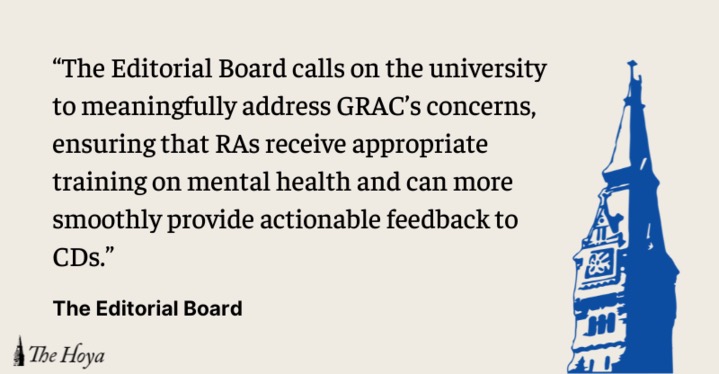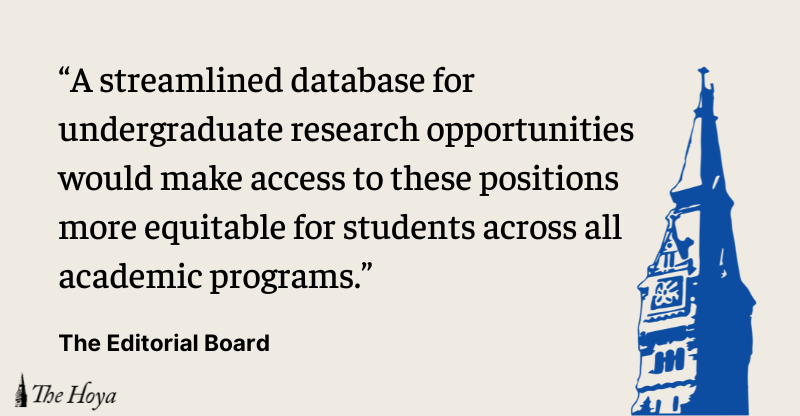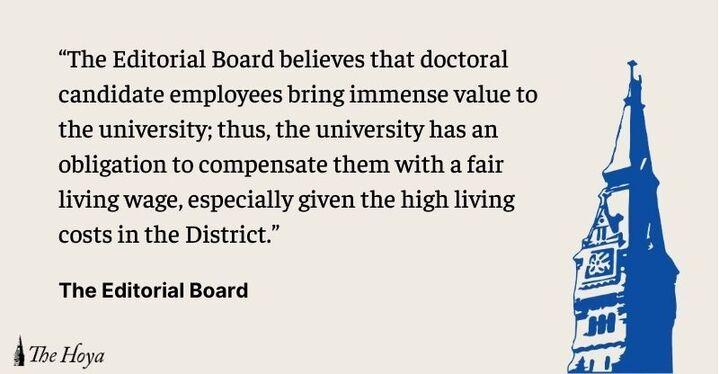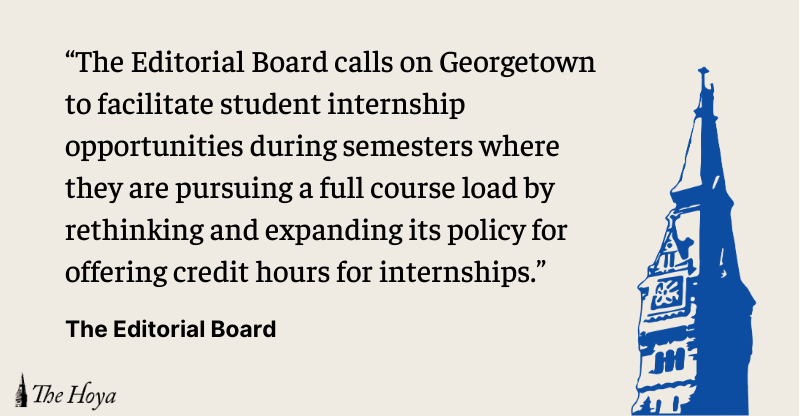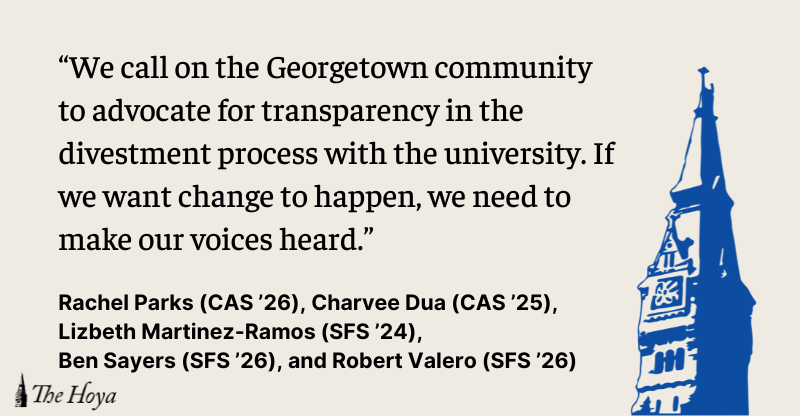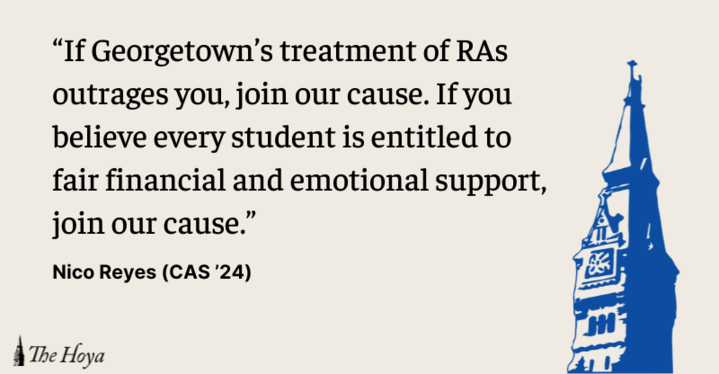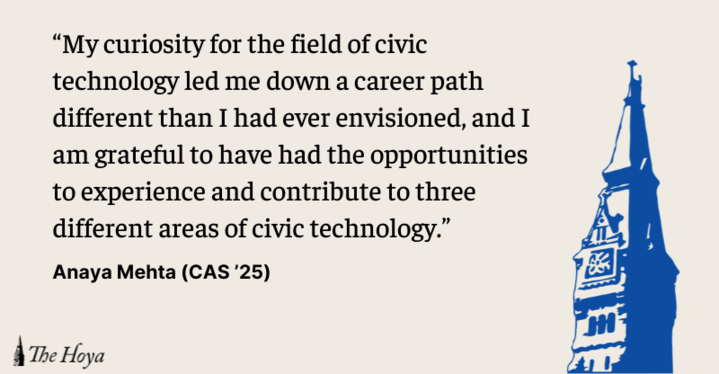Every year, traditional end-of-semester Georgetown Day celebrations see hundreds of Georgetown University students take part in all-day parties across campus.
This year’s Georgetown Day on April 26 will look different. On April 17, Georgetown officials informed students via mass email of new restrictions for Georgetown Day, including limited access to residence halls, strictly enforced noise codes on campus and requirements for students to register parties and guests on the Village A dormitory rooftops. The restrictions also apply to outdoor festivities at Alumni Square and university-owned townhouses — sparking student concern that the administration was seeking to eliminate Georgetown Day festivities.
However, the Editorial Board dissents from a selection of these policies for a different reason: they risk making Georgetown Day celebrations dangerous and difficult to control logistically. Further, the Editorial Board encourages the university to be more transparent in communicating these new regulations to students, improving compliance and decreasing student dissent.
Traditional Georgetown Day parties see students cram onto the rooftops of Village A or the lawns of Alumni Square. This year, though, Village A residents must register their parties and distribute wristbands to their guests, according to an email Village A community director Jazmine Anderson Islas sent to residents April 16.
“For GU Day only, Village A will only be accessible for Village A residents (and registered guests). There will be specific wristbands for Village A residents (and their guests),” Anderson Islas’ email read. “All Vil-A residents will be receiving a wristband. Please wear this wristband regardless of if you are partying or not, so GUPD and staff volunteers can identify that you are a Vil-A resident as you come in and out of the building.”
With Georgetown Emergency Response Medical Services (GERMS) headquarters located beneath Village C, Village A is close to ambulances and is a centralized location for emergency responders. However, these strict restrictions and capacity limits for Village A mean students will disperse away from the rooftops, making their parties less accessible and harder to locate for GERMS ambulances.
As students spread across campus, they create an increasingly complex environment for GERMS staffers and ambulances, with the added factors of distance, route complexity and busy crowds to navigate.
Moreover, as students depart from campus to partake in festivities beyond the Georgetown neighborhood, they may well depart from GERMS’ service area — and thus its benefits of familiarity with the area, quick response times and pro bono service.
GERMS did not respond to The Hoya’s request for comment.
In addition to concerns regarding medical assistance for students, the Editorial Board also retains concerns regarding the logistical angle of these regulations, particularly the wristband requirement for the Village A rooftops.
While a university spokesperson presented a clear case in favor of these capacity limitations, the Editorial Board worries that the wristband system will prove ineffective.
“Village A rooftops have limited capacity due to concerns for student safety – when rooftops are overcrowded there is increased risk of injury,” the spokesperson wrote to The Hoya. “We are especially mindful of these capacity limits on high traffic days and want to ensure a safe environment for all those celebrating Georgetown Day this year.”
However, as rumors spread regarding the operation of the wristband system and students look for ways to game it, it loses effectiveness purely through the confusion it creates.
Joe Massaua (SFS ’25) said that he has seen students develop a sort of black market for wristbands.
“They’re creating a constrained supply of these wristbands, which I’ve already seen students attempt to sell,” Massaua told The Hoya. “I can understand the concern about Village A, but their solution, which is a limited supply of wristbands, is difficult.”
Sophia Chang (SFS ’24) echoed these concerns regarding the enforcement of the wristband system.
“I don’t know how they are going to enforce it,” Chang told The Hoya. “People have already started asking me if I have any extra wristbands.”
Furthermore, enforcing strict capacity limits and checking wristbands will place a burden on Georgetown University Police Department (GUPD) officers and other university staff members — staffers that officials could otherwise station elsewhere or put on call to respond to address happenings across campus.
Additionally, restricting the student population atop Village A will discourage students from leaving for a break from the festivities for food, water or to attend classes.
The Editorial Board also urges the university to increase transparency in its communication with students. Different information in different emails to students has further complicated the safety regulations.
For example, an email sent to Southwest Quadrangle residents April 12 announced the establishment of a wristband system for the entirety of Georgetown’s campus to identify students over the age of 21.
Though the university spokesperson later rescinded that statement to the Editorial Board, clarifying that it only applied to certain events, the university never corrected that message to Southwest Quad residents.
Massaua said he feels that the issues the university is trying to handle are legitimate concerns, but the lack of communication has muddled the picture for students.
“Some of these concerns are legitimate, and other ones we just feel like there’s been a deep communication issue,” Massaua said. “All that they have done is just shoot us emails, and there hasn’t really been any attempt to dialogue ahead of time with student leaders.”
The Editorial Board does not contest the need for safety precautions at any university campus celebration, especially Georgetown Day. After all, as the original April 17 email noted, half of all student calls to GERMS during the month of April 2023 occurred on Georgetown Day. Student accusations that the university is hoping to crush student morale are misguided, and the Editorial Board condemns those who spread such claims.
That said, the Editorial Board urges university administration to be more transparent in communicating with students regarding restrictions on campus celebrations and to more thoroughly consider the logistical implications of the policies.
The Hoya’s Editorial Board is composed of six students and is chaired by the opinion editors. Editorials reflect only the beliefs of a majority of the board and are not representative of The Hoya or any individual member of the board.




